ANTIQUE FRENCH VEDETTE TWO TONE WOOD WALL CLOCK WESTMINSTER CHIMES WithVIDEO
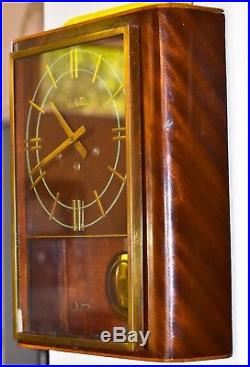
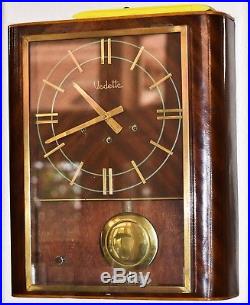
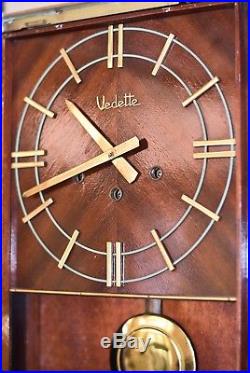
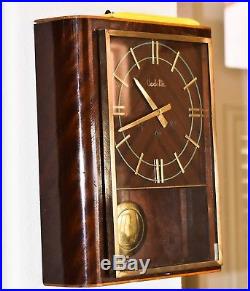
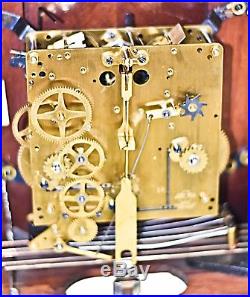
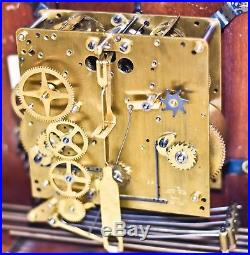
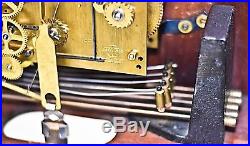

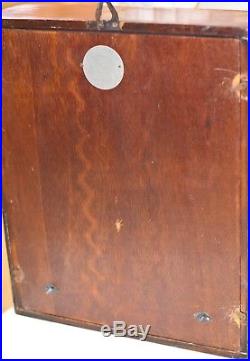

Societe Fabrique de Horlogerie la Vedette built mainly quarter chime wall clocks from 1920's up to the 1960's. They also build mantle, long case, gallery (dial), and electric clocks.
In their later years, they produced early battery powered Quartz clocks. The dual chime (Ave Maria de Lourdes and Frere Jacques) chime mechanisms were patented in 1930. Around 1945, a more compact mechanism was introduced, to suit the smaller cases that became popular at the time. This one up for sale had been cleaned, oiled and rebuilt a couple of years ago, thus in perfect working order. This model is, as i guess from somewhere in the 1940's/50's with a streamlined Art Deco motife, in two tone woods. The clock features Westminster chimes and they are working perfectly. The clock is unusual as it does not have the typical inserted face behind wood, but a wooden face that is the face of the clock with brass inserts for the time. SEE VIDEO OF CLOCK RUNNING HERE. Video will open in a new window. Antique Mantel Clocks Set Up And Care.Antique mantel clocks have their own unique little personalities and you will slowly learn how often your antique mantel clock likes to be wound and how picky it is about where it is placed. First of all setting up your collectible antique mantel clock starts with where you decide to place it. 1-It's ok to move the hour hand (gentley and if it is hard to move stop) to set time or correct bell ring on your antique mantel clock but NEVER move the minute hand other than clockwise. Moving it counter-clockwise will damage your antique mantel clock's mechanism.
Another method of setting the correct bell chime is to move the minute hand to the 11 and then back to the 9 until the clock strikes properly. (Not all clocks accept this). Generally to set time only.
Use the minute hand, stopping slowly just before the hour and half hour. Of your antique mantel clock, giving the bell a chance to set up.
2-Do not move your antique mantel clock with the pendulum attached and swinging freely. 3-Never put a marble antique clock on its side as they are cemented together and built to stand erect. 4-Wind your antique clock every five to six days (so the clock does not become sluggish in 7th or 8th day) and wind both of the holes on your antique clock until they are tight. 5-Adjustments should never require great amounts of force. 6-Dont be intimidated, as pendulum clocks were typically designed to be set up and maintained by their owners without the benefit of a clock maker.
Your most important tool will be a small, inexpensive pocket level. With this you will need to make sure that wherever you position your antique mantel clock, that the surface is very level, especially from left to right.The swing of the pendulum inside the clock which hangs down and swings from right to left will be affected if the clock is not level. The front to back level should also be reasonably level because you do not want the pendulum resting on the bell or back wall or it will not run. These clocks were typically placed on top of a fireplace mantel (which is where the name mantel clock comes from).
Next is placing the pendulum on the pendulum rod. This can be done by opening the swinging metal door on the back of your clock (assuming you have a door and not just an opening) or you can remove the back panel on many clocks.
The pendulum rod (located in the back of the movement) is where you will place the pendulum on the hook at the bottom of the rod, being careful not to move the rod upwards while doing so. Moving the rod upwards may displace it. Once done you can either gently lift the clock just a bit on its end and gently down again, or move the pendulum to start it swinging. You will then be listening for an even tick/tock. A clock out of beat is a cause of poor time keeping for pendulum clocks.An even beat or tick is the sign of a well running clock. A limping or uneven tick is the sign of a sick one. The tick tock should be even in a well running clock. Should the tick/tock not be even and your antique mantel clock not continuing to run, you will need to do the following: If you are a beginner at collecting antique mantel clocks and if your clock is not level, you can adjust the side up that your level indicates with coins, shims, washers, etc. So as to raise the clock to become even from side to side.
For the experienced clock owner, if the surface is even, you can slightly and gently bend the crutch (the wire that the pendulum slots into) in the direction of the shim or the end you raised in order for the clock to beat evenly. This will allow you to put it "in beat" without having any potentially unsightly additions on your mantel place. Antique French mantel clocks are more precise and less forgiving than antique American clocks and will require a bit more effort to set them up. If you cannot wind the clock before leaving town, gently stop the pendulum because if the strike runs down first it may jam the timekeeping (or running) train, and it will not start evenly when rewound. The slight and gentle bending back and forth as well as up and down of the strike hammer rod allows you to adjust how the hammer falls on the bell.
In order to achieve the tone and resonation you desire, firmly hold the hammer rod at the middle with a needle nose pliers and use your free hand to raise or lower the hammer head end of the rod, allowing a minor space between the hammer and the bell. Never move the hammer without bracing it or you may rip it.Sounds Do Not Match The Time. Bring the minute hand (longest hand) to the hour and count the number of strikes. Move the hour hand (shortest hand) to the number the clock struck (forward or backward). If the clock reads 12:00 and strikes 8:00, move the hour hand (shortest) forward to 8:00.
Set the clock to the correct time. A weekly regular feather dusting will help reduce dust build up, but twice per year use a vacuum cleaner nozzle with a soft brush attachment to fully remove all dust from crevices and cracks. Use abrasives such as brass or metal cleaners on anything but a non laquered. Should you do so it will remove any gilding, painting, or other. Please avoid moving your antique clock around when.
Dial glass can be cleaned by applying a very. Small amount of Windex directly to a clean cloth and the glass carefully rubbed.
And then wiped dry with a clean paper towel or soft cloth. Here is a good link for clock information. The item "ANTIQUE FRENCH VEDETTE TWO TONE WOOD WALL CLOCK WESTMINSTER CHIMES WithVIDEO" is in sale since Wednesday, June 13, 2018. This item is in the category "Antiques\Decorative Arts\Clocks". The seller is "ira1942" and is located in Las Vegas, Nevada.This item can be shipped to United States.
- Type: Wall Clocks
- Style: Art Deco
- Age: 1940-1950
- Primary Material: Wood
- Maker: VEDETTE
- Original/Reproduction: Original
- Color: Brown
- Country/Region of Origin: France
